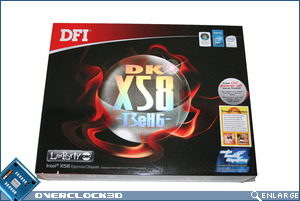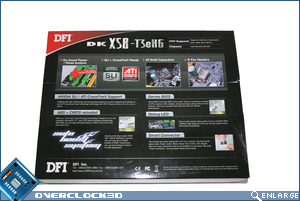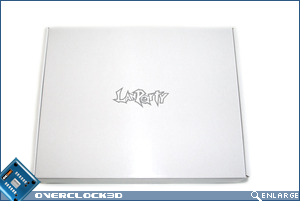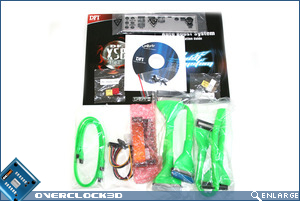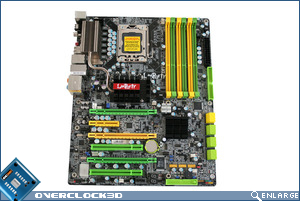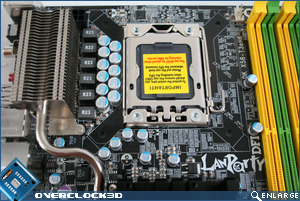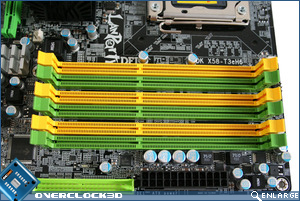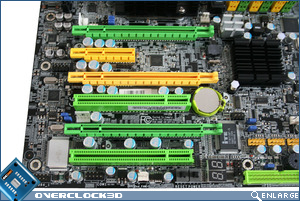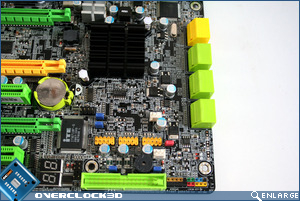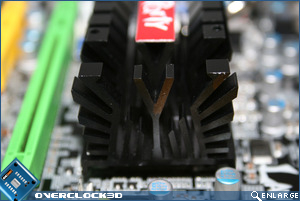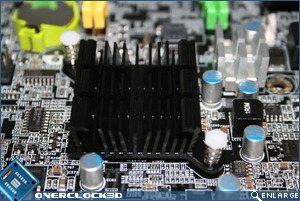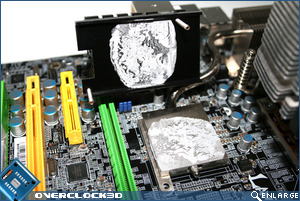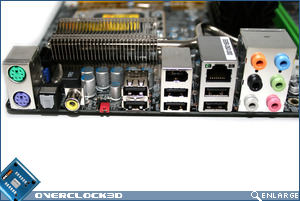DFI Lanparty T3eH6 DK X58 Motherboard
Packaging & Appearance
Â
The exterior packaging is very attractive with the main title being holographic in appearance surrounded by a red smoke effect. DFI definitely seem to have ‘grown up’ and have now stepped away from the cartoon style designs we are familiar with instead being more ‘adult’ in approach. Along with the Auto Boost emblem, two additional stickers on the front of the box also state that the OC power off issue is resolved with this product and that DFI now include ‘smart connectors’ to allow easy fitment of motherboard headers. The rear of the box goes into much greater detail and along with Crossfire/SLI features, all solid capacitor design, 6 fan headers and On-board power/reset switches, the T3eH6 also has a debug LED, Genie BIOS and ABS+CMOS reloaded features.
Â
Â
Removing the inner box from the outer sleeve, we are greeted with a plain white cardboard box with a silver Lanparty emblem atop. While nothing extra ordinary, little touches like this go some way to making a product stand out from the crowd. The included accessories are nothing remarkable, being the standard DFI UV reactive green cabling, driver disk and flexible SLI/Crossfire bridges included. Two manuals are included, the motherboard manual and the Auto Boost Manual. While the motherboard manual is a standard affair with confusing layouts, diagrams and poor instruction as found with most other motherboards, the Auto boost manual is in contrast well laid out, excellent pictures and documented very well in plain English. IÂ would definitely like to see this design incorporated into the main motherboard manual as it is much easier to follow but perhaps more expensive to produce.
Â
Â
At first glance the mainboard looks very similar to the T3eH8 motherboard we have reviewed earlier however there are a few key differences such as this board is regulated by analogue power delivery rather than digital. The cooling design is also slightly different from the flagship board in that it is not as complex (and thereby probably not as good). This has allowed DFI to cut the costs down considerably and allowed followers of DFI to buy their favourite brand without the need to remortgage the house! The rear of the motherboard is nothing to different from the flagship product but as per previous designs, still has the anti-tamper glue on the screws which makes removing the NB and Mosfet cooling tricky. I would prefer to see spring loaded screws used instead of the glue as this should prevent the screws from unscrewing by accident but make the cooling replacement that much less troublesome. Adding to the problem is the number of SMD’s near the screws which can easily break off with one slip of nose pliers needed to hold the nut in place.
Â
Â
The CPU socket area is a slightly more cluttered than the T3eH8 due to the fact that the T3eH6 has analogue PWM as opposed to digital. Yeah that’s right, analogue. DFI market the PWM as digital when in fact they are really analogue but can be controlled by the SM bus where previously the analogue design did not allow this. The T3eH6 operates on 6+2+2 phase modulation (CPU, VTT, Memory) which can be reduced to 2+2+2 when in an idle state thanks to DFI’s power saving features.
Â
The colour scheme of the motherboard is typical DFI Green and Yellow affair with the PCI, SATA, PATA and memory slots all co-ordinated together on a black PCB backdrop. This design is certainly eye catching but IÂ would have preferred a different scheme to differentiate this motherboard to others found in the Lanparty range. Previously DK boards were adorned with orange and yellow slots which was very attractive but DFI seem reluctant to carry this colour scheme over to the X58 range for some reason (cost?).
Â
Â
The PCI area is very well laid out and affords the user the possibility of running TRI-SLI or CrossfireX. The two full length PCIe slots are both PCIe 2.0 standard and operate with 16 lanes each. However the middle yellow PCIe slot is locked to 4x transfer rate and while this may deter some, a PCIe 2.0 4x slot is not a lot different from a PCIe 1.1 16x slot so it’s only cards such as the 4870×2 and GTX295 that require such mammoth bandwidth at present and as such are likely the only cards that would be affected by any great margin. That aside I do like the way in which DFIÂ have configured this area. Having the fastest slots the furthest apart should allow for good airflow as opposed to competitors solutions who have the slots next to each other. A further 4x PCIe slot sits below the uppermost 16x slot with standard PCI slots placed adjacent to the lowest PCIe 16x slot.Â
Â
The T3eH6 features a Marvel 8053 LAN chip which DFIÂ claim can increase Network speeds by upto 15%. Below this chip is the Debug LED that can display 33 different codes which is invaluable when troubleshooting, be it an overclocking oversight or worse, a hardware fault. Interestingly, DFI provide 3 additional internal USB headers internally while no bracket is included to take advantage of this solution. Both Floppy and IDE ports are still catered for with this board and upto 8 SATA devices can be used. Sadly, as with all DFIÂ motherboards, cables that are of the latching type do not work very well with this socket type as they do not ‘lock’ into place.
Â
Â
The Northbridge cooling is interesting as the fins are designed such that as much surface area is cooled at once. Perhaps the best part about the Northbridge is the ingenious design DFI have implemented – it can be removed! Those who wish to add there own waterblock or indeed fancy some extreme LN2 cooling can simply remove the northbridge heatsink without having to removed the whole heatpipe assembly. Just two screws hold the aluminium finned heatsink to the baseplate which itself is attached to sintered heatpipes allowing much greater heat transfer than standard heatpipes.
Similarly, the Southbridge is also finned but is not attached to the heatpipe assembly nor is it screwed to the motherboard, rather it is attached via the use of ‘old skool’ push-pins.
Â
Â
The I/O backplate area is a fairly average affair offering a single LAN port, 6x USB 2.0 ports, P/S2 Mouse and keyboard ports. Audio is provided with 6 x 3.5mm jacks, Toslink optical output creating 7.1 surround courtesy of the Realtec ALC889 chip. Rounding off the I/O area is the little red jumper which is used to give the CMOS a full reset as opposed to using the power and reset buttons simultaneously. With the board out of the case this jumper can be useful however with the I/O shield in place, replacing this red jumper with one of the provided bigger black jumpers allows better handling. Despite this and while it is a welcome feature, most motherboard manufacturers use a much easier to use design in the form of a button as fiddling around the back of your case in the dark is not very easily done with a jumper.
Â
Â
All things considered, the DFI T3eH6 DK X58 motherboard is a very well presented board that has many of the features it’s bigger brother has. The cooling, while not as extravagant appears to be effective enough to keep the temperatures in check and while DFI have opted for a hybrid analogue PWM design, the 6+2+2 phase power circuitry should be such that the motherboard performs to a high standard.
Â
Let’s take a look at the DFI’s BIOS which no doubt is one of the main attractions of owning a DFIÂ motherboard…



